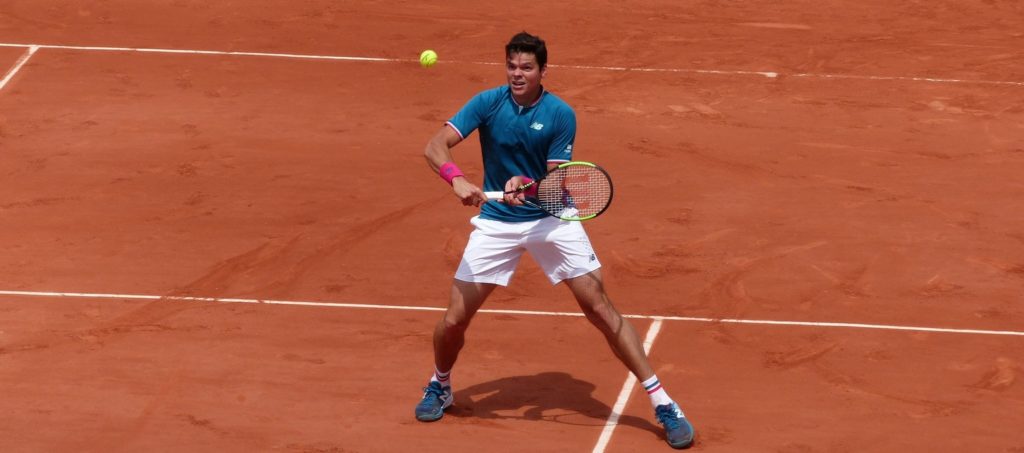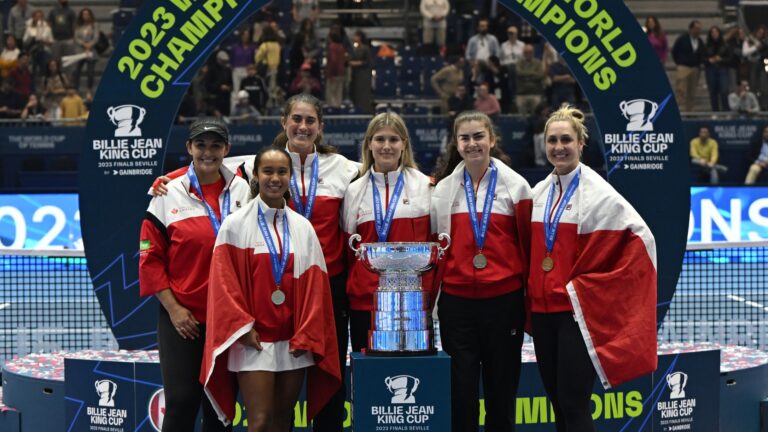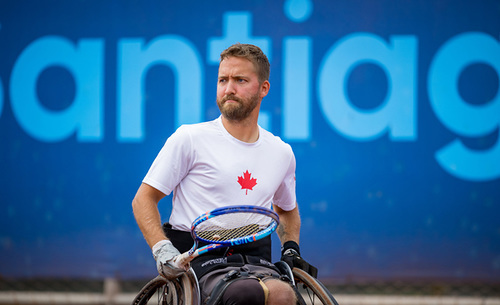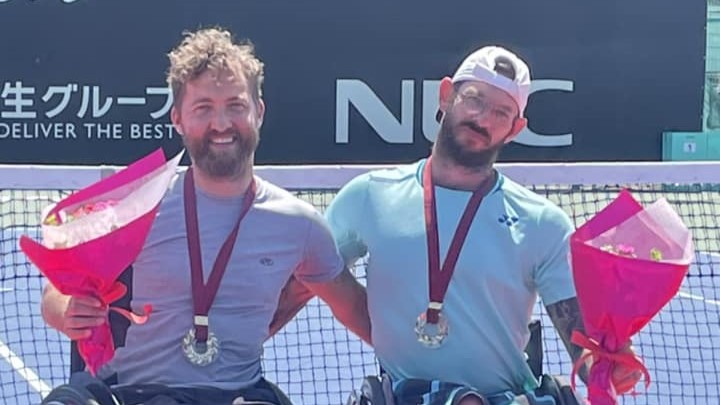
Pablo Carreno Busta called it “the best victory of my career” while Milos Raonic had only two words to describe the end result – “heavy disappointment.”
A more impartial observer might call it un match dingue (a crazy match), a match that contained momentum shifts, match-point drama and a unlikely rash of service breaks before Carreno Busta prevailed in the round-of-16 encounter 4-6, 7-6(2), 6-7(6), 6-4, 8-6 in a rousing four hours and 17 minutes.
He did so on his seventh match point with a winning forehand volley – only the fourth point he won at the net in the final set compared to 15 for Raonic.
There were many twists and turns before it got to that point – including Raonic having two set points in the second set to take a two-set lead but missing first with a backhand service return and then with a forehand service return. No doubt the way back for Carreno Busta would have been considerably more challenging from two sets down.
Service breaks were the order of the day – Raonic converted 6/18 break points while Carreno Busta made good on 7/17 – and there was an exchange of breaks in the third set before a tiebreak that Raonic led 6-4 with two sets points before Carreno leveled at 6-6. Then Raonic won a point helped by a net cord and followed up with a strong serve-and-volley to take a two-sets-to-one lead.
In the fourth set, the players exchanged breaks early until Carreno Busta broke at 3-all and made it hold up.
The mayhem amped up in the fifth set as the players traded early service breaks before Carreno Busta seemed to assume control breaking a seemingly fading Raonic again – this time to love – setting the stage for him to serve for the match at 5-4. But Raonic revived, played lockdown, refuse-to-miss tennis and saved three match points before evening the set at 5-5.
He held serve comfortably to 6-5 with some big forehands and won the first point in Carreno Busta’s next service game. At that juncture when he misfired with a forehand and a backhand, both wide, in this reporter’s notebook was the notation, “first misses in a while.”
He had played brilliantly from the baseline, matching forehand for forehand with Carreno Busta, but maybe more importantly backhand for backhand. But Carreno Busta held serve and then got what proved to be the critical break as Raonic lost his serve to love at 6-all, finishing with a lame backhand drop shot attempt into the net.
But there were still more heroics for Raonic as he fended off three more match points, and even had a break point to level at 7-7 only to float a backhand wide after a 21-stroke rally. The end finally came when Carreno Busta angled a wide approach to Raonic’s backhand and went in and knocked off the aforementioned forehand volley to wrap up the match in front of a boisterous crowd on Court One.
“This is the match that you dream of when you are young,” a happy Carreno Busta said afterward, “playing Roland Garros, five sets, four and a half hours…”
Then he offered the ultimate truth about any heated competition – “I suffered but I enjoyed. And of course if you win, you enjoy more.”
Raonic gave a detailed analysis of his match, saying, “I just wasn’t very efficient, especially through the first three sets. I had a lot of times where I’m controlling the point and short forehands that I wasn’t very efficient with – just let him stick around in those moments. Then he started to believe a lot.
“He was the better player towards the end. I hung on as much as I could, but definitely lacked some efficiency from the aggressive side of my game.”
It was hard for Raonic to take positives from what was a truly intense, madcap battle in the last few games – with both players red-lining their games. It was no consolation at that moment, but he had come very close to winning against a dogged competitor who grew up on clay and is one of the better players on the surface. And, without being disrespectful to the 25-year-old Spaniard, the match-up would likely not be nearly as competitive if the two were to meet on grass over the coming weeks – as they did last year in the first round at Wimbledon with Raonic winning 7-6(4), 6-2, 6-4.
Carreno Busta had remained firm and unwavering facing the Raonic onslaught of big serves and monster forehands. It reflected what Grigor Dimitrov had said about him after he lost to the current world No. 21 in the previous round 7-5, 6-3, 6-4.
Looking ahead to Sunday’s match-up, Dimitrov said on Friday about Carreno Busta, “he fights pretty much every point, and he was able to do it over and over again today.”
Anything less and it would have been Raonic who would have been moving on to play Rafael Nadal in Tuesday’s quarter-finals. About the disappointment of not getting to the quarter-finals and facing the nine-time champion, Raonic said, “first of all, beyond who is there, I wanted to be in the next round. And then, obviously that being, for me at least, the most difficult challenge there is – you take the best guy on the surface that I have the least natural style for, and it’s a big challenge.
“I play tennis to face challenges.”
His next one for him will be the grass court season – Queen’s Club beginning in two weeks and then Wimbledon a week later.
The good news is that he has come out of the clay court season physically healthy. He has played 16 (11-5) matches over five consecutive weeks on arguably the most demanding surface in the sport and avoided the injuries that ruined much of his first four months of the year.
“The body is good,” he said, “so I’m happy about that.”
Wimbledon will probably always be his best chance to win a Grand Slam title – and that was evident in his runner-up finish to Andy Murray a year ago. Nothing would have been worse than to be carrying an injury heading into his most important four or five weeks of the year.
As for who will be working with him besides his main coach Riccardo Piatti – Raonic was non-committal when asked about whether Richard Krajicek, who was with him in Australia this year, would be rejoining the team. Apparently there is still some negotiating to be done.
Hard to believe that Krajicek could resist – as John McEnroe couldn’t last year – working with someone who looks primed to break through on the grandest stage in tennis.
DOUBLES KNOCK OUT
Adil Shamasdin and his Argentine partner Andres Molteni were ousted in the third round of the doubles on Saturday, beaten 7-5, 6-2 by the pairing of Julio Peralta of Chile and Horacio Zeballos of Chile.
The 34-year-old Shamasdin, who has been on a good run in doubles the past few months, was pretty blunt about the nature of the match.
“They played better than us today,” he said, “and to be honest it didn’t come down to one or two points. They were on us and we didn’t have anything to counter-attack that.”
Reaching the third round will improve Shamasdin’s current career-high No. 47 ranking. But he has a quarter-final (with Jonathan Marray from a year ago) to defend at Wimbledon.
In the meantime he will play with Santiago Gonzalez of Mexico at the s-Hertogenbosch grass-court event next week and then hopes to find a partner to play the remaining tournaments in the grass-court season.
Gabriela Dabrowski and her Chinese partner Xu Yifan advanced to the third round of the women’s doubles on Saturday with a one-sided – they led 6-1, 5-0 at one point – 6-1, 6-2 victory over Madison Brengle of the U.S. and Anna Smith of Great Britain.
“Today I felt we were getting pretty good rhythm off the returns – we had a lot of looks at returns to always make them play the second shot,” the 25-year-old Dabrowski said about the win over Brengle and Smith. “When you just focus on holding your own serves and then seeing the opportunities on the return game, then it’s easier to build confidence than if you’re being blown off the courts with serves.”
On Sunday they were not blown off the court by serves but they did not have their best outing and, as ninth seeds, were beaten 6-3, 3-6, 6-2 by the unseeded team of Raluca Olaru of Romania and Olga Savchuk of Ukraine.
Olaru and Savchuk were sharper and more on the ball than Dabrowski and Xu who won the big WTA Mandatory event – the Miami Open – in April.
JUNIORS DEBUT
Bianca Andreescu of Mississauga, Ontario, was the only Canadian to progress through the first round of the Roland Garros junior singles on Sunday. Seeded No. 3, the promising 16-year-old had little trouble defeating French wild card Loudmilla Bencheikh 6-1, 6-2. In her next round she will face a fellow 16-year-old, Wang Xiyu of China.
Carson Branstine of Montreal lost her opening round match 3-6, 6-3, 6-1 to Paula Arias Manjon. Now representing Canada after winning the Australian Open junior girls doubles title with Andreescu while playing for the U.S. last January, Branstine is 16 while her Spanish opponent Manjon is 17.
Ben Sigouin, who reached the quarter-finals of the French Open juniors a year ago, was beaten in the first round on Sunday by Oliver Crawford. The 18-year-old American, seeded No. 10, edged the 17-year-old Sigouin 6-3, 4-6, 7-6(5).
PARIS POST CARD
This is a chain of wine stores seen all over Paris. When the service person in this one in Paris 4ieme was asked for the cheapest bottle you could buy – he pointed out a blend offered by the Nicolas chain that costs three euros ($4.60 Canadian). When asked how it tasted, he said, “you tell me – come back at 10’clock tomorrow morning.”
Without being a wine expert, this humble blogger found it thin with hardly a trace of so-called ‘body.’ In fact it tasted like it had been diluted about two thirds with water!
NOTE: No blog on Monday – back on Tuesday with Tebbutt Tuesday.











